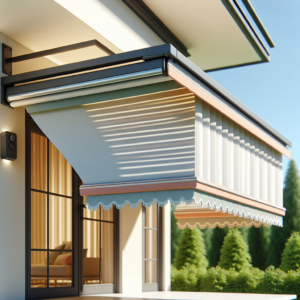Electric awnings have become increasingly popular due to their ease of use and ability to transform outdoor spaces. Whether you want to create a shaded retreat in your backyard or protect your business’s outdoor seating area from the elements, electric awnings can provide the perfect solution. But before you rush into a purchase, it’s crucial to understand what sets them apart and how to choose the one that suits your needs best.
Benefits of Electric Awnings

Convenience at Your Fingertips
One of the most significant advantages of electric awnings is the convenience they offer. With just a push of a button on your remote control, you can effortlessly extend or retract the awning. Say goodbye to the hassle of manually cranking the awning in or out, especially during inclement weather.
Electric awnings are designed with user-friendly remote controls that simplify operation. This convenience makes them ideal for anyone, regardless of age or physical ability. Whether you want to create shade on a scorching summer day or shelter from unexpected rain, it’s all at your fingertips.
Energy Efficiency
Electric awnings can also contribute to energy savings. By providing shade during hot summer days, they reduce indoor cooling costs. Conversely, during colder months, retracting the awning allows natural sunlight to enter, helping to heat your space naturally.
When your home or business enjoys energy-efficient solutions, you not only save money but also reduce your environmental footprint. It’s a win-win situation that speaks to the growing interest in sustainable living and responsible business practices.
Types of Electric Awnings

When it comes to electric awnings, you’ll find several types to choose from:
- Retractable Awnings: These are the most common and versatile type, offering the flexibility to extend or retract as needed.
Retractable awnings are perfect for those who appreciate adaptability. Whether you prefer full sunshine or partial shade, retractable awnings allow you to adjust accordingly. It’s like having a customizable outdoor space at your disposal.
- Fixed Awnings: These are permanently installed and provide continuous shade and protection.
Fixed awnings are a reliable choice if you want constant shade and protection from the elements. They’re ideal for outdoor seating areas, patios, or storefronts that require a consistent shield against the sun, rain, or snow.
- Semi-Cassette Awnings: A hybrid between retractable and fixed, offering partial protection when retracted.
Semi-cassette awnings combine the benefits of both retractable and fixed awnings. When retracted, they provide partial coverage, making them suitable for spaces where you want some shade but don’t need full protection.
Each type has its unique benefits and considerations, so take your time to evaluate which one aligns best with your specific requirements.
Considerations Before Buying

Size and Measurement
Before purchasing an electric awning, accurately measure the space where you intend to install it. Ensure that the awning’s dimensions align with your needs, providing adequate shade or coverage.
When it comes to size, consider the area you want to shade. A smaller awning may suffice for a cozy backyard nook, but a larger one might be necessary for a spacious outdoor dining area. Measuring the available space is the first step toward finding the perfect fit.
Budget and Pricing
Electric awnings come in a wide range of price points. Set a budget and explore options within your financial constraints. Keep in mind that higher-quality materials and additional features may come at a higher cost.
When considering your budget, think beyond the initial purchase price. Factor in the long-term savings on energy bills and the potential increase in property value. Investing a bit more upfront for a high-quality electric awning can pay off in the long run.
Features to Look for

Remote Control
A remote control is a standard feature for electric awnings. Look for a user-friendly remote with simple buttons for smooth operation.
Remote controls are designed to be intuitive, allowing users to extend or retract the awning with ease. Some remotes even come with programmable settings, enabling you to customize your awning’s operation based on your preferences.
Sensors
Many electric awnings come equipped with sensors that detect changes in weather conditions. These sensors can automatically retract the awning in strong winds or extend it when the sun is intense.
Weather sensors add an extra layer of convenience and protection to your electric awning. They ensure that your awning responds to changing weather conditions without requiring your constant attention. This feature is especially valuable if you live in an area with unpredictable weather patterns.
Materials
Consider the materials used in the awning’s construction. High-quality fabrics and durable frames will ensure longevity and resistance to weather elements.
The choice of materials impacts the awning’s durability and aesthetics. UV-resistant fabrics maintain their color and integrity over time, while sturdy frames ensure stability during operation. Investing in quality materials means fewer maintenance concerns and a longer lifespan for your awning.
Installation Process

While some might attempt a DIY installation, it’s strongly recommended to hire a professional for this task. Proper installation ensures that the awning functions smoothly and is secure, reducing the risk of accidents.
Professional installation guarantees that your electric awning is safely and securely mounted. Installation experts have the knowledge and experience to ensure that your awning operates flawlessly, giving you peace of mind and avoiding potential safety hazards.
Maintenance and Care
To prolong the life of your electric awning, regular maintenance is essential. Clean the fabric and frame as recommended by the manufacturer, and inspect for any wear and tear. A well-maintained awning can serve you for many years to come.
Maintaining your electric awning is a straightforward process that involves routine cleaning and inspections. Regular cleaning prevents dirt buildup, while inspections catch minor issues before they escalate. Following the manufacturer’s guidelines for maintenance ensures the longevity and performance of your awning.
Warranty and Customer Support
Always inquire about the warranty offered with your electric awning. A good warranty reflects the manufacturer’s confidence in their product. Additionally, consider the level of customer support provided by the manufacturer or retailer in case you encounter any issues.
A warranty provides peace of mind, knowing that you have a safety net in case of unexpected problems. Be sure to read and understand the warranty terms and conditions, including coverage and duration. Additionally, opt for brands or retailers known for responsive customer support, ensuring you have assistance when needed.
Customer Reviews and Ratings
Before making your final decision, take the time to read customer reviews and check ratings. Hearing from others who have purchased the same product can provide valuable insights and help you avoid potential pitfalls.
Customer reviews offer real-world perspectives on the product’s performance, quality, and customer service. Look for patterns in the reviews to identify common strengths or weaknesses. Remember that a product with consistently positive reviews is more likely to meet your expectations.
Conclusion
In conclusion, choosing the right electric awning involves considering your specific needs, budget, and available space. Electric awnings offer convenience and energy efficiency, making them a valuable addition to any home or business. By following the guidelines in this buyer’s guide, you’ll be well-equipped to select the perfect electric awning for your outdoor space.




